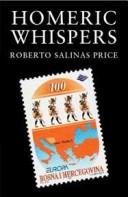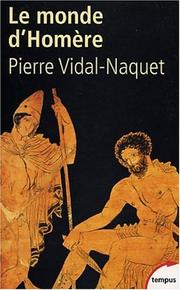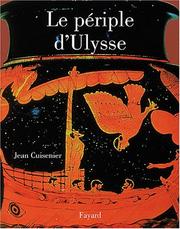| Listing 1 - 10 of 23 | << page >> |
Sort by
|

ISBN: 0910865116 9780910865111 Year: 2006 Publisher: San Antonio : Scylax,
Abstract | Keywords | Export | Availability | Bookmark
 Loading...
Loading...Choose an application
- Reference Manager
- EndNote
- RefWorks (Direct export to RefWorks)
Geography, Ancient, in literature. --- Troy (Extinct city). --- Homer --- Homer --- Iliad.
Book
Year: 1998 Publisher: Genova : Università di Genova,
Abstract | Keywords | Export | Availability | Bookmark
 Loading...
Loading...Choose an application
- Reference Manager
- EndNote
- RefWorks (Direct export to RefWorks)

ISBN: 2262018995 9782262018993 Year: 2002 Publisher: Paris: Perrin,
Abstract | Keywords | Export | Availability | Bookmark
 Loading...
Loading...Choose an application
- Reference Manager
- EndNote
- RefWorks (Direct export to RefWorks)
Civilization, Homeric --- Epic poetry, Greek --- Geography, Ancient, in literature --- Homer --- Homer --- Greece
Book
ISBN: 8478823409 9788478823406 Year: 1998 Volume: 3 Publisher: Madrid : Ediciones Clásicas,
Abstract | Keywords | Export | Availability | Bookmark
 Loading...
Loading...Choose an application
- Reference Manager
- EndNote
- RefWorks (Direct export to RefWorks)
Classical geography in literature --- Geography, Ancient, in literature --- Mediterranean Region --- Geography --- Classical geography in literature - Congresses --- Geography, Ancient, in literature - Congresses --- Mediterranean Region - Geography - Congresses --- Geographie --- Univers --- Histoire --- Representation

ISBN: 2213615942 9782213615943 Year: 2003 Publisher: Paris: Fayard,
Abstract | Keywords | Export | Availability | Bookmark
 Loading...
Loading...Choose an application
- Reference Manager
- EndNote
- RefWorks (Direct export to RefWorks)
Book
Year: 1970 Publisher: Tilburg : H. Gianotten,
Abstract | Keywords | Export | Availability | Bookmark
 Loading...
Loading...Choose an application
- Reference Manager
- EndNote
- RefWorks (Direct export to RefWorks)
Epic poetry, Latin --- Aeneas (Legendary character) in literature. --- Geography, Ancient, in literature. --- History and criticism. --- Virgil --- Virgil --- Language.
Book
ISBN: 8886413351 Year: 1998 Publisher: Padova Esedra
Abstract | Keywords | Export | Availability | Bookmark
 Loading...
Loading...Choose an application
- Reference Manager
- EndNote
- RefWorks (Direct export to RefWorks)
Book
ISBN: 9789004388628 9789004388635 900438863X 9004388621 Year: 2019 Publisher: Leiden Boston
Abstract | Keywords | Export | Availability | Bookmark
 Loading...
Loading...Choose an application
- Reference Manager
- EndNote
- RefWorks (Direct export to RefWorks)
"In Making Mesopotamia: Geography and Empire in a Romano-Iranian Borderland, Hamish Cameron examines the representation of the Mesopotamian Borderland in the geographical writing of Strabo, Pliny the Elder, Claudius Ptolemy, the anonymous Expositio Totius Mundi, and Ammianus Marcellinus. This inter-imperial borderland between the Roman Empire and the Arsacid and Sasanid Empires provided fertile ground for Roman geographical writers to articulate their ideas about space, boundaries, and imperial power. By examining these geographical descriptions, Hamish Cameron shows how each author constructed an image of Mesopotamia in keeping with the goals and context of their own work, while collectively creating a vision of Mesopotamia as a borderland space of movement, inter-imperial tension, and global engagement"--
Geography, Ancient, in literature. --- Imperialism in literature. --- Latin literature --- Borderlands --- History and criticism. --- History. --- History --- Iraq --- Rome --- Iran --- Historical geography. --- Description and travel --- Sources. --- Relations
Book
ISBN: 9780190221232 0190221232 0190493348 0190221259 0190221240 Year: 2016 Publisher: Oxford : Oxford university press,
Abstract | Keywords | Export | Availability | Bookmark
 Loading...
Loading...Choose an application
- Reference Manager
- EndNote
- RefWorks (Direct export to RefWorks)
Literary Territories introudces readers to a wide range of literature from 200-900 CE in which geography is a defining principle of literary art. From accounts of Holy Land pilgrimage to Roman mapmaking and the systematization of Ptolemy's scientific works, Literary Territories argues that forms of literature that were conceived and produced in very different environments and for different purposes in Late Antiquity nevertheless shared an aesthetic sensibility which treated the classical "inhabited world," the oikoumenē, as a literary metaphor for the collection and organization of knowledge. This type of "cartographical thinking" stresses the world of knowledge that is encapsulated in the literary archive. The archival aesthetic coincided with an explosion of late antique travel and Christian pilgrimage which in itself suggests important unifying themes between visual and textual conceptions of space. Indeed, by the end of Late Antiquity the geographical mode appears in nearly every type of writing in multiple Christian languages (Greek, Latin, Syriac, and others). The diffusion of cartographical thinking throughout the real-world oikoumenē, now the Christian Roman Empire, was a fundamental intellectual trajectory of Late Antiquity. -- from dust jacket.
Literature, Ancient --- Geography in literature. --- History and criticism. --- Cartography --- Cartography. --- Classical literature --- Classical literature. --- Geography, Ancient, in literature. --- LITERARY CRITICISM / Ancient & Classical. --- History --- To 1500.
Book
ISBN: 9782251014937 2251014934 Year: 2021 Publisher: Paris Les Belles Lettres
Abstract | Keywords | Export | Availability | Bookmark
 Loading...
Loading...Choose an application
- Reference Manager
- EndNote
- RefWorks (Direct export to RefWorks)
Poème géographique composé dans le troisième quart du IVe siècle ap. J.-C., l’Ora maritima se présente, pour sa partie conservée, comme une description des régions côtières depuis les Colonnes d’Hercule (détroit de Gibraltar) jusqu’à Marseille, avec un excursus initial vers l’Extrême Occident et un second le long du cours du Rhône. Amateur de connaissances livresques anciennes et de sources rares, Aviénus présente un monde archaïque oublié, agrémenté de toponymes et d’ethnonymes en grande partie inconnus par ailleurs, ce qui a suscité l’intérêt des historiens et des archéologues. En outre, en bon connaisseur de la poésie grecque et latine, il recourt au trimètre iambique, réminiscence d’une tradition didactique hellénistique, et agrémente son poème d’échos intertextuels conformément à l’esthétique de son temps. En situant Aviénus dans son contexte intellectuel, ce volume entend rendre à l’auteur une originalité trop souvent estompée par le seul débat sur le statut de ses sources. La nouvelle édition critique de ce poème latin sans témoin manuscrit conservé prend pour point de départ le texte de l’édition princeps (parue à Venise en 1488), tout en examinant les nombreuses corrections et hypothèses interprétatives formulées par les érudits pendant cinq siècles. Le commentaire cherche à adopter des approches complémentaires (philologique, littéraire, historique, géographique, archéologique…) permettant de rendre compte de la richesse d’un texte qui pourra intéresser des spécialistes de différents champs disciplinaires
| Listing 1 - 10 of 23 | << page >> |
Sort by
|

 Search
Search Feedback
Feedback About UniCat
About UniCat  Help
Help News
News